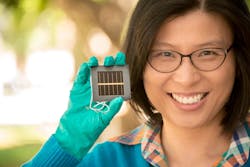Perovskite photovoltaic cell from University of New South Wales reaches record efficiency of 12.1% for large device
Engineers from the Australian Centre for Advanced Photovoltaics (ACAP) at the University of New South Wales (UNSW; Sydney, Australia) have bested the world efficiency record for solar cells made of perovskite. The new 12.1% efficiency rating was for a 16 cm2 perovskite solar cell, the largest single perovskite photovoltaic cell certified with the highest energy-conversion efficiency, and was independently confirmed by Newport Corp. (Bozeman, MT). The new cell is at least 10 times bigger than the current certified high-efficiency perovskite solar cells on record.
Describing the results at the Asia-Pacific Solar Research Conference (Canberra, Australia) on Friday 2 December, 2016, Anita Ho-Baillie, a Senior Research Fellow at the, announced that her team at UNSW had also achieved an 18% efficiency rating on a 1.2 cm2 single perovskite cell, and an 11.5% for a 16 cm2 four-cell perovskite mini-module, both independently certified by Newport.
"This is a very hot area of research, with many teams competing to advance photovoltaic design," says Ho-Baillie. "Perovskites came out of nowhere in 2009, with an efficiency rating of 3.8%, and have since grown in leaps and bounds. These results place UNSW among the best groups in the world producing state-of-the-art high-performance perovskite solar cells. And I think we can get to 24% within a year or so."
Perovskite is a structured compound, where a hybrid organic-inorganic lead or tin halide-based material acts as the light-harvesting active layer. They are the fastest-advancing solar technology to date, and are attractive because the compound is cheap to produce and simple to manufacture, and can even be sprayed onto surfaces.
"The versatility of solution deposition of perovskite makes it possible to spray-coat, print or paint on solar cells," says Ho-Baillie. "The diversity of chemical compositions also allows cells be transparent, or made of different colors. Imagine being able to cover every surface of buildings, devices, and cars with solar cells."
Although perovskites hold much promise for cost-effective solar energy, they are currently prone to fluctuating temperatures and moisture, making them last only a few months without protection. Along with every other team in the world, Ho-Baillie's is trying to extend its durability. Nevertheless, there are many existing applications where even disposable low-cost, high-efficiency solar cells could be attractive, such as use in disaster response, device charging, and lighting in electricity-poor regions of the world. Perovskite solar cells also have the highest power-to-weight ratio among viable photovoltaic technologies.
The UNSW project's goal is to lift perovskite solar cell efficiency to 26%.
Ho-Baillie, who obtained her PhD at UNSW in 2004, is a former chief engineer for Solar Sailor, an Australian company which integrates solar cells into purpose-designed commercial marine ferries which currently ply waterways in Sydney, Shanghai, and Hong Kong.
Source: https://www.eurekalert.org/pub_releases/2016-12/uons-psc120116.php

John Wallace | Senior Technical Editor (1998-2022)
John Wallace was with Laser Focus World for nearly 25 years, retiring in late June 2022. He obtained a bachelor's degree in mechanical engineering and physics at Rutgers University and a master's in optical engineering at the University of Rochester. Before becoming an editor, John worked as an engineer at RCA, Exxon, Eastman Kodak, and GCA Corporation.
